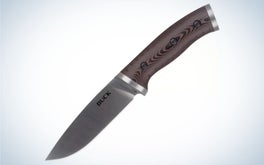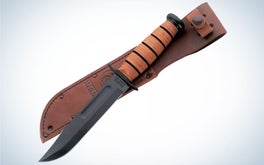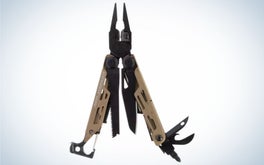| Best Fixed Blade Survival Knife |

|
Buck Selkirk Fixed Blade Survival Knife | SEE IT |
LEARN MORE
|
Summary
It’s a durable survival knife that’s strong and easy to re-sharpen. |
| Best Tactical Survival Knife |

|
KA-BAR USMC Fixed-Blade Knife | SEE IT |
LEARN MORE
|
Summary
It’s a time-tested tactical utility knife. |
| Best Survival Multitool |

|
Leatherman Signal Multi-Tool | SEE IT |
LEARN MORE
|
Summary
This multitool provides an array of emergency preparedness features backed up with a heat-treated, high-carbon 420 stainless steel blade. |
We may earn revenue from the products available on this page and participate in affiliate programs. Learn more ›
A survival knife is a crucial piece of gear for outdoors people, but what exactly is a survival knife? A survival knife is a multi-function blade that you can use for a variety of tasks, from butchering wild game to carving wood to build temporary shelters and more. It is among the most important pieces of survival equipment. There are many different kinds of knives that will work well in survival scenarios, from camping knives to compact folding blades to Ka-Bar knives. Regardless of what type of knife you’re looking for, you need to get a knife that you can rely on in dicey situations. Here’s how to choose a survival knife, plus our five recommendations.
- Best Fixed Blade Survival Knife: Buck Selkirk Fixed Blade Survival Knife
- Best Folding Blade Survival Knife: Benchmade Crooked River Folding Knife
- Best Tactical Survival Knife: KA-BAR USMC Fixed-Blade Knife
- Best Survival Multitool: Leatherman Signal Multi-Tool
- Best Cheap Survival Knife: Cabela’s Expedition Fixed-Blade Knife with Paracord Wrap
Types of Knives Designed for Use in Survival Situations
There are many different types of knives that will be a benefit in survival scenarios. The most common style of a survival knife is an oversized fixed blade knife. These are typically pretty bulky and between 7 and 9 inches long. These knives are versatile and burly enough for numerous heavy duty tasks, including whacking brush and cutting wood. While this type of knife is one of the best options for survival scenarios, it’s not the only option. You could also opt for smaller, folding knives that are easier to transport but will still perform well when you need them to. There are even several solid survival knife multitools on the market today that come equipped with features such as compasses, which can help you get out of a survival situation and to civilization.
Nobody wants to be in a survival situation, but you need to think about where you’ll most likely be in one if it happens in order to choose the best survival knife. Are you planning to pack your knife with you into the backcountry? Consider a lightweight, compact blade. Are you going to keep your survival knife in your car? Think about how your knife complements your car emergency kit. Do you want a do-it-all knife or a knife that can do double duty, such as a butcher game? Read on for details.
The Classic Large Knife for Strength
The classic style of a survival knife is a big, fixed blade knife. These knives are strong, and the oversized blade can be especially beneficial in survival situations. A big knife with a sharp blade can handle many tasks except for those requiring precise cutting, and can handle jobs such as making firewood by pounding the blade against a log with another piece of wood. Large survival blades can also help you bushwack a path back to safety. The biggest drawback here is size. A big blade is just that—big. If you’re on the move or trying to pack light, a large survival blade will add extra weight and bulk.
If you do go for a big blade, you need to make sure that it has several key attributes. Large survival knives should be easy to sharpen so that you can keep them functioning with little effort. They should have a solid grip. And they should also be very strong.
Best Fixed Blade Survival Knife: Buck Selkirk Fixed Blade Survival Knife
It’s a durable survival knife that’s strong and easy to re-sharpen. cabelas
Buck knives are known for their strength, and the Buck Selkirk Fixed Blade Survival Knife is a solid do-it-all survival knife. The 4 ⅝-inch 420HC stainless steel drop-point blade is easy to resharpen–a key feature if you’re going to be using the knife for rough tasks. The sturdy rear bolster allows you to use the knife as an emergency hammer tool. The hard sheath can pivot for three different kinds of carry, and contains a firestarter/whistle.
The Folding Knife for Ease of Carry
Fixed blade knives are stronger and more durable than folding knives, but they’re also bulkier and need to be carried in a sheath. The most important part of owning a survival knife is having it with you when you really need it. This means being able to carry it with you—which makes a folding survival knife a smart choice for many people. In the past, folding knives were significantly weaker than fixed blade knives. Today, that’s not the case. There are plenty of folding blade hunting and survival knives that are more than strong enough for survival tasks. Of course, folding blade knives always have a weak point at the joint, but a quality folding blade knife will have plenty of strength. Look for a strong blade with a handle that provides a good grip.
Best Folding Blade Survival Knife: Benchmade Crooked River Folding Knife
The Benchmade Crooked River Folding Knife is an extremely well made folder designed to perform well in adverse conditions. The 4-inch clip-point blade locks open solidly thanks to a sturdy locking mechanism, and the long curving laminate hardwood handle is easy to hold and balances well. The pocket clip allows the knife to stay upright when you store it in your pocket.
The Tactical Knife for Self-Defense
Some survival scenarios may call for a knife that’s well designed for self-defense if needed. That said, using a knife as a weapon is a last resort, and you’re infinitely more likely to use your knife for mundane tasks such as cutting cord and carving wood. Still, several survival knives have military origins and are designed for self defense.
Such tactical knives are not made with hunting—and butchering—in mind. You’re more likely to find a clip point blade than a drop point blade. The former is designed for piercing; the latter for butchering game. Tactical knives also tend to be large and designed for power instead of finesses.
Best Tactical Survival Knife: KA-BAR USMC Fixed-Blade Knife
The Ka-Bar USMC Fixed-Blade Knife is modeled after a combat knife that was created for the Marines in 1942. It has a classic look, and the 1095 carbon Cro-Van steel blade is super-strong. The leather-washer grip provides a firm hold even when wet.
The Survival Multitool for Numerous Tasks
Several companies manufacture top-notch multitools that work well in survival scenarios. When you’re looking for a survival multi-tool, you need to look for two things. First, the multi-tool should feature a beefy blade that is strong enough to use for real work. Then, you need features that you would actually use in a survival situation, such as a firestarter or mini saw.
Best Survival Multitool: Leatherman Signal Multi-Tool
This multitool provides an array of emergency preparedness features backed up with a heat-treated, high-carbon 420 stainless steel blade. cabelas
The Signal is Leatherman’s survival knife offering, and it’s a good one. It comes with a solid blade as well as practical features such as wire cutting needle-nose pliers, a fire-starting ferro rod, a diamond-coated sharpener (an excellent addition, since blades will see rough use in a survival situation), and an emergency whistle.
The Budget Survival Knife: What You Get for Under $20
High-quality survival knives can range anywhere from $60 or $70 up into the high hundreds. At a certain point, you’re paying as much for style as for functionality, but generally, you get what you pay for in terms of blade quality. Higher priced knives are generally made with better steel that is sharper and lasts longer.
However, if you’re on a budget, there are plenty of affordable survival knives. You won’t get an extremely high blade quality or a fancy wooden handle, but you should still be able to find a sharp, functional knife. Make sure that you can comfortably grip the knife and sharpen the blade easily.
Best Cheap Survival Knife: Cabela’s Expedition Fixed-Blade Knife with Paracord Wrap
It’s a well-made bare-essentials survival tool at a low price point. cabelas
Cabela’s Expedition Fixed-Blade Knife with Paracord Wrap is a sturdy drop point blade that features a cord cutter notch for added versatility. The handle is wrapped in paracord that can also be utilized in emergency situations, though removing the paracord would diminish the knife’s grip.
FAQs
Q: Should a survival knife be serrated?
A survival knife does not need to be serrated. A plain edged knife is typically recommended for survival scenarios because it cuts clean and can be sharpened easily. Serrated blades make irregular cuts and are hard to maintain, though they do a good job at cutting rope and fabric. If you are interested in a serrated survival knife, It should be your secondary knife.
Q: What to look for in a survival knife?
You should look for three main things in a survival knife. First, it should be easy to sharpen. Second, it should have a good, comfortable grip. And third, it should suit the tasks that you may have to do.
Q: What is the best survival knife in the world?
The best survival knife in the world is a matter for endless debate. There are some long-time favorites, such as Ka-Bar knives, but the real answer to the question is whatever knife keeps you alive when you really need it.
The Final Word on Survival Knives
Whether you go with a large fixed blade knife, a tactical knife, or a compact folder, make sure the blade is strong, durable, and easy to maintain. A dull knife will hinder your ability to survive, and a broken blade will diminish it significantly.






